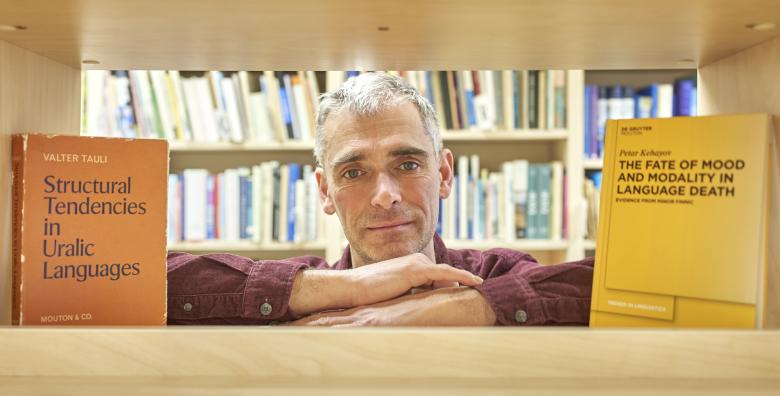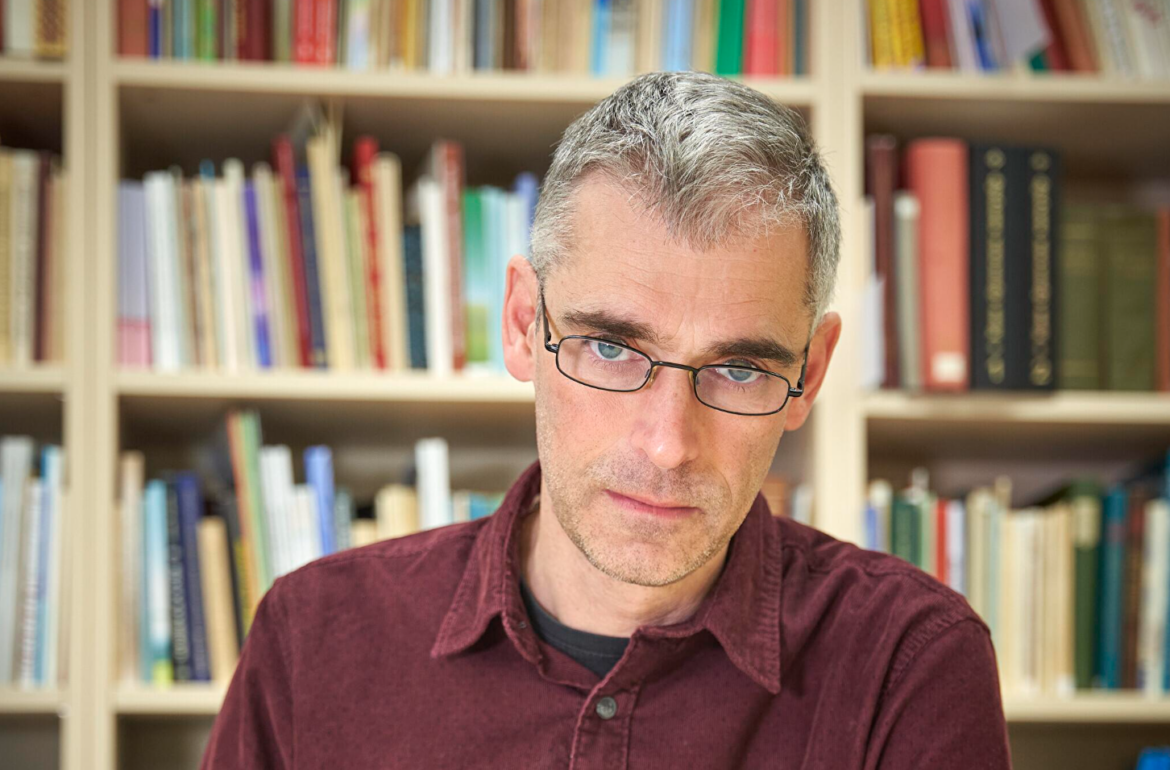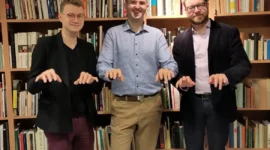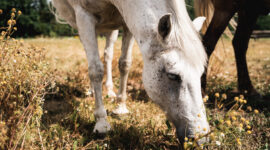Petar Kehayov, from Sofia, the capital of Bulgaria, came to the University of Tartu to study linguistics as a young man in the 90s. Now a professor of Finnic languages, he is particularly interested in language extinction.
In Tartu, Petar Kehayov completed his Bachelor’s, Master’s and doctoral theses. In 2016, he defended his habilitation dissertation“The Fate of Mood and Modality in Language Death: Evidence from Minor Finnic” at the Ludwig Maximilian University of Munich, and then worked for several years in Germany at the University of Regensburg and the University of Munich.
Since February 2023, Petar Kehayov has been a professor of Finnic languages at the University of Tartu: he teaches Finnic linguistics and studies the Karelian, Veps, Lude, Ingrian and Mordvinic languages.
From Sofia to Tartu
We meet at the legendary Werner cafe, with the cheerful buzz of cafe-goers in the background. We first talk about his choice of specialty. It turns out that Kehayov first studied history at the University of Sofia after high school, but did not connect with the subject.
“I also had the opportunity to learn Finnish at the university,” he says. “I was fascinated by how different it was from the Indo-European languages. One summer, I attended a language course in Kuopio, where I met Estonians for the first time in my life.”
The situation in the Balkans back then was quite tense – Yugoslavia was collapsing and war was breaking out. The early 1990s were also a turbulent time in Bulgaria. “Nobody really knew what to do with their lives. I thought it would be interesting to come to Estonia and study Finno-Ugric languages.”
In the summer of that language course, Kehayov bought an Estonian language textbook, published in 1928 by Lauri Kettunen and began to learn Estonian on his own.
“The professor Ago Künnap came up in the stories of the Estonians I met in Finland, and I decided to write to him in Estonian,” he says. A month later, he received a reply from the University of Tartu: welcome to our university! “They were probably impressed that someone from abroad was writing to them in Estonian,” he muses.
He moved to Tartu at the end of August 1994, a week before the last Soviet soldier left Estonia.
“I lived in a dorm with other foreigners,” he says. “Most of them were Finnish, and during the first few years, my Finnish improved significantly. I started to study Estonian as a foreign language and also took Finno-Ugric subjects. Back then, it was easy to be a foreign student in Estonia, as Estonians still saw foreigners as exotic and interesting.”
Tartu was close to Kehayov’s heart – his favourite book in childhood was Spring by Oskar Luts. But Estonia was still nearly 2000 kilometres away from Bulgaria. In the second half of the 90s, he didn’t see his family for five years because he would have had to join the military service if he went home. To keep in touch, he used to call home a few times a month from a central long-distance calling room at the end of Rüütli Street. “My Bulgarian went downhill – after all, I was hardly speaking it at all,” he recalls.
Studying linguistics layer by layer
Linguistics began to open up to him layer by layer in Tartu. “I had a good friend, Rogier Blokland from the Netherlands, who is now a professor of Finno-Ugric languages at Uppsala University,” says Kehayov.
“Rogier already knew as a student that he wanted to become a linguist. He collected books on Finno-Ugric languages and always talked about them, and so I became really interested. Mati Erelt, the supervisor of my Master’s and doctoral theses, was another important influence. Thanks to him, I began to understand what scientific thinking is all about, how one should study a language and what kinds of choices one should make in their research.”
As time went on, writing a research paper became easier and easier. “By nature, I was not good at time management,” Kehayov admits. “I got better at it, but it took some time.”
Kehayov’s Master’s and doctoral theses were on grammatical evidentiality, i.e. the linguistic devices used to communicate the source of information and the way it is obtained. An example of such a linguistic device in the Estonian language is the reported evidential speech, where the speaker states something they have not witnessed themselves: Mari õppivat prantsuse keelt (Mari is said to be learning French).
“My supervisor was interested in evidentiality, and I got to study the Balkan languages as a part of that,” he explains. “Later on, I also studied a range of other phenomena – for example, modality, i.e. the linguistic devices by which the speaker estimates the probability, permissibility, possibility and so on, of the action verbalised. In the Estonian language, modality is expressed through modal verbs, sentence structure as well as with adverbs, like in the sentence Ilmselt võib ta suusatada (He can probably ski). I studied how modality is expressed in the Finnic languages.”
Endangered small languages as laboratories
Petar Kehayov first visited the Votians for field work in 1997 with Heinike Heinsoo, who at the time was the main researcher of the Votic language both in Estonia and in the world. Later, he also visited East Setomaa and Karelia.
“During the fieldwork, I started to realise that Estonian and Finnish linguists have traditionally been in search of the most pure and authentic forms of language,” he explains. “The search is for the best Finnic speaker in the community, usually the oldest, who has had the least contact with the outside world and lived in their village their entire life. This kind of ‘ideal’ speaker is overrepresented in the data archived. It occurred to me: what if we instead searched for ‘bad’ speakers and compared their speech with that of the ‘good’ speakers?”
This idea determined the future direction of Kehayov’s research.
He is particularly interested in everything to do with the extinction of languages. Kehayov says that a scientist does not “save” languages, although they may try to do so – their task is to describe the process from the outside. The Finnic languages in Russia are ideal “laboratories” to study language extinction at the level of the individual speaker.
“Of course, one could also conduct sociolinguistic research into how communities become smaller,” he says. “But at the level of the individual, what is interesting is how those who mastered their mother tongue in childhood but have since spent decades working in a larger Russian-speaking environment speak differently than those who were already more fluent in Russian in childhood. Which linguistic features are more permanent and which ones disappear faster?”
To study modality, he created questionnaires, as this kind of knowledge does not become apparent in casual conversation. “Gradually, I began to see patterns,” he says. “The research itself is always done later in the privacy of my office: I process all the data, conduct statistical analyses and spot trends that are not discernible to the naked eye.”

War caused a communication barrier
Russia’s war in Ukraine has of course also affected the study of Finnic languages.
“From a scientific perspective, our situation is pretty solid: we have a lot of archival material and recordings still to be studied,” Kehayov says. “However, it is no longer possible to observe the changing linguistic situation in the field.” Contact with colleagues from both Moscow and Petrozavodsk has been almost completely lost and the war has created a communication barrier. Fortunately, we can still collaborate with researchers who have fled Russia.
Language consultants – the native speakers from whom language data is collected – have also become hard to reach. Kehayov has been sending them holiday cards every year, even after the war broke out, but he does not know if they have ever received them.
“I found a recording made with a consultant’s mother in 1987 in the archives, burned it onto a CD and sent it to her, but it never arrived,” he says. “I don’t know if there’s any point in sending anything these days. I do find it important to keep in touch with the consultants until the day they die. Scientists should maintain contact, assure them that they are not enemies despite living on the other side of the border, that the world is not black and white and that they are not to blame for what is happening.”
The research fields at the Institute of Estonian and General Linguistics are connected. The Estonian language and its dialects are part of the Finnic languages and are therefore also included in Finnic linguistics. The Finnic languages are in turn part of the Uralic language family – in this respect, Finnic linguistics falls under Uralic linguistics.
“There are of course also transition zones and grey areas,” explains Kehayov. “Professor Gerson Klumpp is responsible for the study of Uralic languages, and I for the study of Finnic languages. The Mordvinic languages are an example of a transition zone between them, because they are the closest linguistic relatives of the Finnic people to the east and he is a specialist of more eastern Uralic languages.”
There is an even greater transition zone between the Estonian language with its dialects and the Southern Finnic languages. “While the Võro and Seto languages fall under Estonian dialects, they have acquired, or are acquiring a status of, distinct Finnic languages,” notes Kehayov, who himself is able to help his colleagues with the Karelian, Veps and Lude languages.
Traditionally, linguists at the University of Tartu investigating Uralic languages have mainly studied the history of languages – how languages and dialects diverge. As a researcher, Kehayov is particularly interested in developments over the last three to four hundred years.
“In this regard, I am more of a synchronic linguist, studying language as it is nowadays or in the recent past,” he says. “I see great potential in studying how the development of society, culture and the economy over the past few centuries is linked to language development.”
Two professors worldwide
Aside from Tartu, there is only one other professorship of Finnic languages in the world: across the gulf at the University of Helsinki, led by Riho Grünthal.
“Riho and I get along very well, and in a way I am walking in his steps,” says Kehayov. “He is interested in the position of the Finnic languages among the other Uralic languages. He is particularly interested in Mordvinic languages; he’s more fluent in the Erzya language while I am better at the Moksha language.”
Professor Riho Grünthal, on his part, does not hold back on his appreciation, writing the following as a response to our request for him to describe his colleague: “Petar has a rich understanding of the Finnic languages. It’s quite remarkable that he has managed to acquire such closely related but sociologically very distinct languages so well. He is a very high-level and professional linguist and a wonderful and intelligent colleague.”
According to Kehayov, there has been a shift in linguistics in the past few decades that causes him a bit of concern. In fact, there are a number of young researchers who have a strong basis in quantitative methods, but the younger generation has slightly lost the habit of reading everything about the phenomenon investigated in the existing literature before applying modern methods to study it.
“Method is not what determines everything,” says Kehayov. “Perhaps we should get to know the material first and only then decide on the methods? There should be more narrow experts in specificfields than there are now. If we stop training such researchers and they disappear, the know-how will also forever be lost.”
The professor considers collaboration with other disciplines to be essential. “Linguistics has always aspired to be a natural science – not really an exact science like physics, but it has the much in common with psychology, neuroscience and biology. I believe that we should look in all directions, including the humanities as well.”
In his view, Finno-Ugric minority literature of the first half of 20th century, for example, is practically unresearched from a linguistic perspective. “This is where we could collaborate with literary scholars: study linguistic choices and dialect variation in prose and poetry.”
When asked how a linguist spends his free time, Kehayov says that he goes to the gym and goes on hikes with his friends.
“Sometimes I go to the bar, talk to my friends, walk the dog. But when it comes to hobbies… I have mixed feelings. On the one hand, linguistics should be a hobby for life, so that you like it. On the other hand, you have to take it professionally, not as a hobby, but as a profession with which you contribute to society. It’s a tricky thing – if you take linguistics too professionally, it ceases to be a hobby; there should still be a certain lightness so that your passion for it doesn’t fade.”
Issues of identity and language
Language extinction is on the rise. Currently, four to five indigenous languages die out each year. Of the Finnic languages closest to Estonia, the Votic language is now extinct. In 2022, language extinction was also addressed by the UN, which proclaimed the period of 2022 to 2032 as the International Decade of Indigenous Languages. Its aim is to increase the numbers of indigenous language speakers, improve their language skills and encourage speaking indigenous languages in public life.
Are there any benefits to this?
Petar Kehayov says, “Although I don’t know too much about it, I still think that the UN International Decade of Indigenous Languages is a great initiative that will provide many opportunities for meetings. This is more of an issue for activists rather than linguists, but I still believe that it is important to communicate with each other and share experiences.
“However, the issue of language extinction is controversial. We are living in an age where post-colonial discourse includes minorities – put simply, this means that the colonial era is over and the traumas arising from it are now being tackled by dealing with victims, minorities and identity in general. Identity is highly valued and minorities are at the forefront. We support them, sometimes also at the expense of the majority, but this is the zeitgeist of our Western liberal society. At the same time, everything to do with ethnicity and nationality is also stigmatised and intuitively pushed to the background.
“On the one hand, the disappearance of communities affects minorities that need support, but on the other hand, this is accompanied by a strong emphasis on ethnicity. Do we care more about the Izhorians than for the Crimean Karaites? Both languages are dying out, but one of them is related to us, and so we opt to focus more on the lanhuage of Izhorians than the Crimean Karaites. In our concern for linguistic minorities, there is a hint of our own ‘old-fashioned’ nationalism.
“In protecting the linguistic and cultural rights of Uralic minorities, we are engaging in identity politics. Here, we run a risk of getting trapped. Our liberal background expects us to side with individual rights and freedoms, but in reality we are pursuing a collective agenda: we seek to protect a language rather than the individual freedom of a representative of the minority. But if they have the freedom to choose who they are, this could actually endanger minorities, as the ‘free’ choice people make is often to be Russian rather than, for example, Karelian. There is a built-in paradox here that we should be wary of. We need to talk about it more.”
This article was originally published on the University of Tartu’s newspaper Universitas Tartuensis Author: Kristel Algvere, University of Tartu – Junior Research Fellow in Linguistics
 Back
Back



